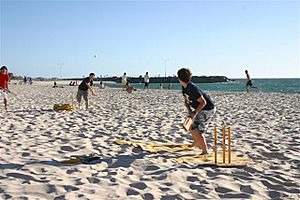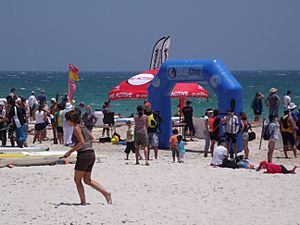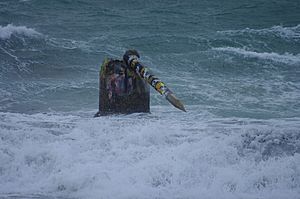Cottesloe, Western Australia facts for kids
Quick facts for kids CottesloePerth, Western Australia |
|||||||||||||||
|---|---|---|---|---|---|---|---|---|---|---|---|---|---|---|---|

View of Cottesloe Beach in summer 2007
|
|||||||||||||||
| Population | 7,375 (2016 census) | ||||||||||||||
| • Density | 2,256.9/km2 (5,845/sq mi) | ||||||||||||||
| Established | 1870 | ||||||||||||||
| Postcode(s) | 6011 | ||||||||||||||
| Area | 3.856 km2 (1.489 sq mi) | ||||||||||||||
| Location | 11 km (7 mi) WSW of Perth CBD | ||||||||||||||
| LGA(s) | Town of Cottesloe | ||||||||||||||
| State electorate(s) | Cottesloe | ||||||||||||||
| Federal Division(s) | Curtin | ||||||||||||||
|
|||||||||||||||
Cottesloe is a western suburb of Perth, Western Australia, within the Town of Cottesloe. Cottesloe was named for Thomas Fremantle, 1st Baron Cottesloe, a prominent Tory politician and the brother of Admiral Sir Charles Fremantle for whom the city of Fremantle was named. The nearby suburb of Swanbourne was named for the Fremantle family seat, Swanbourne House, in Swanbourne, Buckinghamshire.
Cottesloe was home to Australian Prime Minister John Curtin. The house he built still stands in Jarrad Street. It is now vested jointly in the National Trust of Australia (WA) and Curtin University.
Geography
Cottesloe is a beach-side suburb of the city of Perth in Western Australia. It is located roughly halfway between Perth central business district and the port of Fremantle. It is famous for its beaches, cafes and relaxed lifestyle.
Cottesloe is bounded by the Vlamingh Memorial to the south, Stirling Highway, Congdon Street and West Coast Highway to the east; North Street to the north and the Indian Ocean to the west. A large part of Cottesloe is residential, although a significant shopping area is located along Stirling Highway, and a 9-hole golf course is on Jarrad Street.
At the ABS 2011 census, Cottesloe had a population of 7,398 people living in 2,686 dwellings, 69.5% of which are detached houses on separate lots. In a 2014 estimate there were 8,703 people living in 2,780 dwellings. The ABS identified property and business services and health as the two main occupations.
Present day
Historically the beach and its panorama are reflections of the changes in the last 110 years of Perth's history. The photos and paintings of Cottesloe Beach that are either in collections or published, give tangible evidence of the importance of beach-oriented activities in the Perth community. Cottesloe Beach is a popular place for beach cricket. An oceanway allows pedestrians and cyclists to move along the beaches in a sustainable manner.
In 2009, Lonely Planet named Cottesloe Beach the world's 2nd best beach for families.
A new town planning scheme was approved for Cottesloe allowing developers to build to five storeys high along Marine Terrace with the Ocean Beach Hotel site allowed to reach eight storeys. The decision followed a two decade long debate.
Transport
Cottesloe is served by Swanbourne, Grant Street, Cottesloe, Mosman Park and Victoria Street railway stations on the Fremantle line. Various bus routes along Stirling Highway and through the suburb's western and eastern sections link Cottesloe to Perth and Fremantle. All services are operated by the Public Transport Authority. Cottesloe is serviced by the 102 operated by Swan Transit.
The Pylon
In December 2008 the Town voted to restore the pylon, a concrete structure built in 1935, at a cost of $172,000. Decades of battering by the ocean has eroded the pylon, which was one of three pylons built to anchor a shark net following a fatal attack in 1925. Two were destroyed by storms in 1937. Since then it has become an iconic landmark and popular diving platform for beach users.
During major storm activity on 21–22 May 2009, the spike was knocked off the pylon. However this is not the first time this has occurred: during storms in 1995, the spike was also knocked over. It then remained on the bottom of the ocean in approximately 3 metres of water until an unnamed group removed the 800 kilograms (1,764 lb) structure using nothing but wood and rope.
After the pylon was restored, it was painted in the Cottesloe Surf Lifesaving Club colours, but it was soon changed to the colours of North Cottesloe Lifesaving Club. It has alternated colours many times since.
Notable residents
John Curtin, Prime Minister of Australia for much of World War II, was local federal member of parliament from 1928 to 1931 and 1934 to 1945. He lived in Cottesloe from 1918 until his death in office in 1945. Curtin's house in Jarrad Street is vested in the National Trust of Australia (WA) and Curtin University. During 2008 there was a suggestion that the house be relocated to the Curtin University grounds but the decision was made that the house remain in Cottesloe. In May 2009 the federal government announced that it would provide a grant of $580,000 to the National Trust to restore the house.
Claude de Bernales was a mining entrepreneur who in 1911 bought Attorney-General Richard Pennefather's 1898 Federation Queen Anne house, naming it Overton Lodge. In 1936 it was rebuilt as a 30-room Inter-war Spanish Mission style residence, designed by Bernard Evans. It was bought for £30,000 by the Town of Cottesloe in 1950 and renamed the Cottesloe War Memorial Town Hall and Civic Centre.
Former West Coast Eagles premiership player Chris Mainwaring lived in Cottesloe before his death on 1 October 2007.





